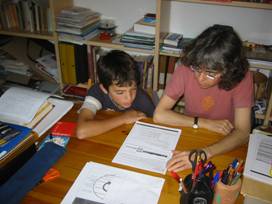
This section focuses on the possibilities that families help their children learn or better internalize the contents of school subjects from home through peer tutoring. This is about constituting pairs where the tutor is a family member (normally the father or mother) and the tutored, a child or adolescent. Studies carried out in the United States and Britain show that the connection between school and family enhances good academic results. In some studies present peer tutoring (among parents and children, grandparents and grandchildren, as well as among brothers or siblings) as a methodology which facilitates the children and family’s social and cultural learning.
Numerous studies (revised for example in Wolfendale & Topping, 1996) show the positive influence of such methodology in children’ s school results when families –parents, grandchildren, brothers or siblings- collaborate with teachers accompanying their school learning from home.
We believe that this possibility is very interesting in a complex and plural society such as ours, regarding both Catalan families and families resulting from immigration.
Teachers usually have experiences about parents’ demanding information from the school as regards the way in which they can help their children learn at school. Although, as shown in studies about this matter, we know that family context plays an important educational role complementing that of the school, some cases –probably with students in higher need of help, and specially in language learning- also show that it can be convenient to offer interaction structures which allow parents to learn from their children about the basic school competences.
Such peer tutoring setting is of special interest if regarded from the point of view of social and linguistic integration and cohesion of newly arrived children and their families. Classroom and home observations of families from Bangladesh in London as developed by Dr. Eve Gregory’s research group at Goldsmits College in the University of London (with whom members of our group have worked with) have recorded playful learning situations in language learning among sisters (peer tutoring) showing that there exists a relationship between the strategies they deploy and the strategies the English school deploys.
In the situations of playful learning among equals, sisters play roles: the smallest one is the student and the oldest one is the teacher. The objective of this type of game is teaching. We could interpret that the oldest sister represents the role of “expert” and provides support and help to her younger sister in the sense of scaffolded learning (Bruner and Vigostky). Thus, the youngest children in the family are initiated in oral and written language learning taking into consideration their oldest sister’s point of view, which favour the interaction between the activity models developed at school.
The teachers in our group note that more channels are open to the families’ participation in Catalonian schools, but these collaborations tend to be one-way, that is, families are normally attracted to do things at the school (for example helping in corners, attending interviews or meetings, celebrating parties, etc.). However, the teaching and learning process is not continued in the family context.
We believe that in student-family peer tutoring the tutor (parent, grandparent, sisters/brothers…) or expert will help the tutored (children) understand certain aspects previously negotiated with the teachers at school (as for instance reading comprehension), through an agreed and structured program.
Moving on from Gregory’s (1996) model as well as from the group’s reflections, we suggest a series of aspects that need to be taken into account when designing an intervention in a project of family continuity and collaboration:
– Define and make the population who will carry it out explicit: group of students, families and teachers involved
– Define the topic and materials the participants will work with, which will need to be accepted both by teachers and family
– Explain and share the method or how to provide help through meetings and with examples as can be seen in a video recording, etc.
– Establish regular meetings of the different groups involved (researchers, family and teachers)
– Share the results of the functioning of the program
– Make sure the program is included in the whole of the school and shared with the rest of professionals
We believe that for this to be truly effective schools need to have a group of teachers who are willing to and prepared for working as ethno graphs, analyzing their own beliefs and practices as well as those of the families they will work with. The family-student peer tutoring, without eliminating the school’s work, will improve the tutor and tutored’s competence in the worked-on subject, will facilitate the families’ participation and will have them share aspects related with learning, all of which we consider essential.
Referències
Gregory, E., (1996) Learning from the community: a family literacy project with Bangladeshi – origin children in London (89 – 116). In Wolfedale and Topping (Ed.) Family involved in literacy. London . Cassell. Podeu trobar una traducció al català en l’apartat de documents i recursos.
Wolfendale, S.W. i Topping, K.J. (Eds). (1996). Family Involvement in Literacy: Effective Partnerships in Education. London: Cassell.